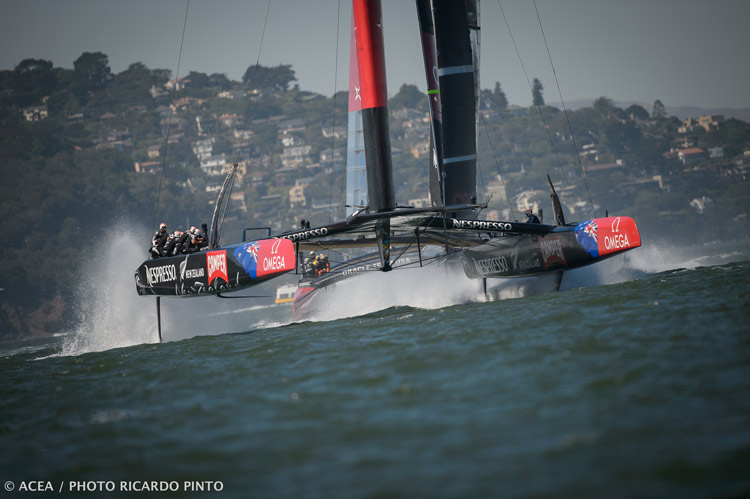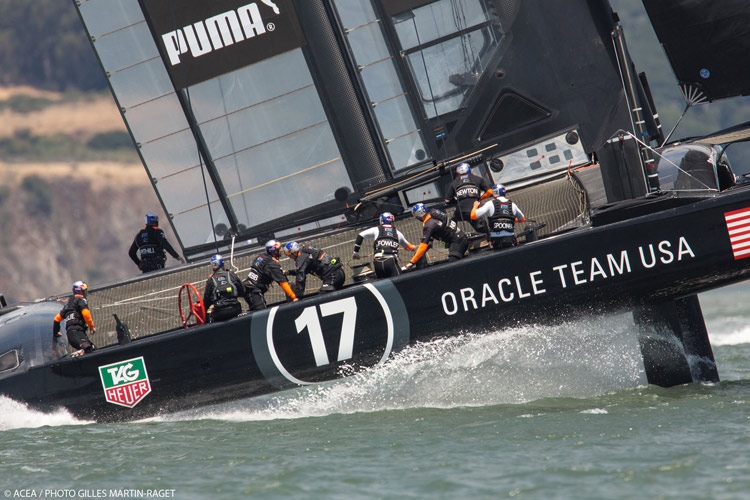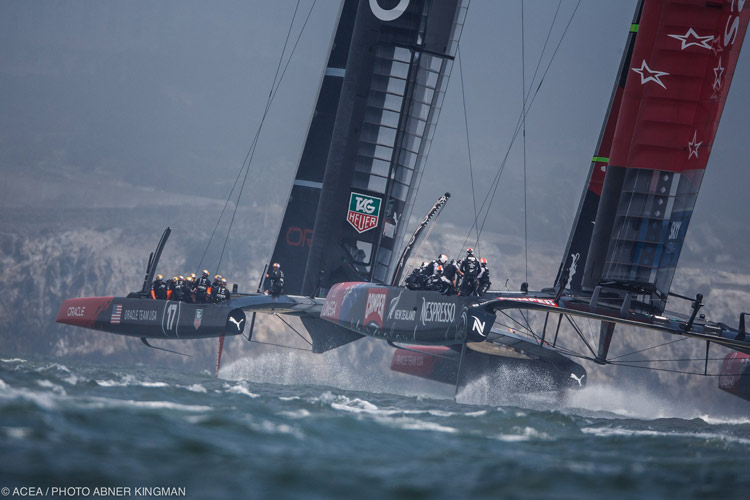Shaping the Foils that Re-Shaped The America's Cup: Part 1
Designer Pete Melvin
Read Part 2
September 15, 2013

Image:©2013 ACEA/Photo: Ricardo Pinto
Pete Melvin first spoke with CupInfo in January of 2011, not long after the Morrelli & Melvin designer/partner had written the AC72 Class Rule and rumors were swirling that he would sign on to create one of the radical new boats for a certain America’s Cup challenger. Now, in 2013, Melvin looks back on his early expectations for the new boats, the cat-and-mouse of testing secret weapons in public, and making 72’ fully-foiling catamarans a reality:
When Pete Melvin co-wrote the design rule for the AC72 catamaran, he knew there were two distinct areas of development that could determine the winner of the 34th America’s Cup; the hard wing, an aspect of Oracle Team USA’s Cup-winning monster cat brought forward to this new era of Cup technology; and the foils. As it turns out, the 130’ wingsail, initially regarded as the radical innovation of this America's Cup cycle, was overshadowed by the realization that these giant catamarans could not only foil downwind but upwind.
From the beginning of Melvin’s role on the AC72 design team of
Emirates Team New Zealand, the watchword was “stable flight.” The team learned
pretty early on that getting as much of the huge cat out of the water as
possible was the key to speed. Consequently, the foils underwent a tremendous
amount of development, from early models tested on the team’s SL33s to the “V”
shaped version that led ETNZ to win the Louis Vuitton Cup, and may carry the
America's Cup back to Auckland.

Flight? Yes. Stability? That took some doing. Oracle Team USA works on the
question back in June.
Image:©2013 ACEA/Photo:
Gilles Martin-Raget
“When we were working on the rule, we knew you wanted to get as much lift as possible when you were going fast downwind,” Melvin says. "For instance, in the 2010 America’s Cup, sailed on giant multihulls, the maximum amount of lift we thought we could get was about 50% of the weight of the boat. At that time, we were still relying on the hull to provide pitch control, so what’s come out of this is the boats all now have elevators (the horizontal foils on the rudders).
“At Team New Zealand, we developed a new type of foil that allows you to keep your height above the water more or less steady. No one had been able to do that before, at least not on a course-racing boat that was not going downwind. We developed that mostly on our SL33 test boats -- they came with the stock constant curvature “C” foils and with those kinds of foils, you can generate 50% boat weight lift before they get unstable. But we noticed that when we could get one boat up fully foiling for a few seconds it would really accelerate away from the other boat – and that got the wheels turning. How, with such a huge potential benefit, can we achieve stable flight downwind? So our design team came up with the “up-tip” type of boards. We refined those on the 33s and our 72 is designed to do that and fortunately it worked right of the box.”
As with any new Cup revelation, ETNZ’s first problem was how to test something as radical as foiling without showing their hand too soon. Opposing teams and sailors now freely admit the sheer number of hours spent on Waitemata Harbor, keeping a very close eye on the Kiwi’s development plans. How did ETNZ keep the prying eyes at bay?
“When we first achieved stable flight, it was on the SL33s and we did a pretty decent job of keeping those sailing sessions out of the eyes of our competitors,” says Melvin. “They would come out every few days and watch us -- and when they did, we would go back into “normal” mode. After a while, they would get bored and go away.
“But they could see what we were developing and they were probably wondering why we were sailing with these strange looking foils, though I’m sure they were figuring out what we were doing just by analyzing the shapes that we had. When we launched our 72, that was then pictures started appearing on the internet. There were cries of it being Photoshop, people couldn’t believe it.”
And now that the foils have been proven to be a success, Melvin can admit that he was even somewhat caught by surprise.
"When we wrote the rule, we honestly weren’t sure if we could fully foil,” says Melvin. “All we knew was the higher the lift we could generate, the faster we could go. That was a central focus of our foil development program, to try to push that limit. Initially, we thought that if we could get 70 or 80% lift, that would be a giant gain over our competitors. The boat would accelerate like crazy, so incrementally we pushed it until we could fly 100% of the time.
“Our initial foils on the 72 were a little more conservative
and even more stable than the foils we have now. Some of it is technique,
though, to achieve stable flight -- steering, trimming and the set up of your
wing and sails, the elevators. We’re still on a very steep learning curve but we
were able to design foils that have less drag, but are a little less stable than
our original foils. There’s a compromise between foiling stability and drag –
you can have larger elevators, which give you more pitch stability, but it’s
more drag. Trialing these solutions and understanding exactly how hard and where
you can push the envelope -- that’s where we had a good advantage initially,
because we had more time on the water doing that.”

Image:©2013 ACEA/Photo: Abner Kingman
All the teams have had to compromise when it comes to foil size and shape -- for instance, a larger foil means the boat can lift at lower wind speeds, but the larger foil means more drag, especially at higher speeds. And the higher speeds bring their own problems, such as cavitation. As Oracle Team USA and ETNZ navigate the trade-off between drag and speed, at least it’s a decision that can wait until nearly the last possible moment -- all foils are pre-measured, so teams have until 8:00pm the night before a race to declare their foils.
As a designer, Melvin enjoyed watching the other America’s Cup teams launch their new boats, seeing how each design team put their personal stamp on the AC72 rule he and his staff put together. While no design truly surprised him, he doesn’t mind borrowing a thing or two he’s picked up along the way, especially from the team they face for the America’s Cup.
“Clearly, we were in a little bit different design space than Oracle. They went for a much more aerodynamic solution but with a little bit of a compromised structure. Their boat was clearly more flexible than ours. We went for a stiffer structure and perhaps gave away some aerodynamics, though I’d say we’ve worked hard on aerodynamics since we’ve seen their boat and they worked pretty hard on stiffening their boat up. With foiling, you need to have fairly good stiffness control of your boat, because if the whole boat is moving it’s hard to control your foils.”
-- Diane Swintal for CupInfo/©2013 CupInfo.com
Part 2: Read Shaping Foils that Re-Shaped the America's Cup with Gino Morrelli (September 2013)
Additional Links and Info:
Read "Behind the Multihull Decision" with Pete Melvin at CupInfo (January 2011)
See Morrelli & Melvin
Design & Engineering site